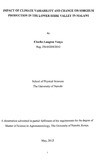| dc.description.abstract | Climate change is likely going to cause changes in the weather patterns over Malawi, which may
include the extreme episodes of rainfall and temperatures. Such drastic weather changes will
have serious impacts on food security in various parts of the country. To cope with such extreme
changes, factors influencing them need to be understood. A simulation study was carried out
using APSIM Model to assess the potential sensitivity of sorghum yield to likely changes in
temperatures and rainfall in the Shire Valley. Three fertilizer management practices which
include ''No application" (0) kg/ha fertilizer, 25kglha of Urea, 50kg.ha Urea were used in the
assessment their contribution towards yield loss.
Impacts of changes in temperature, rainfall and C02 concentration was determined using
individual candidate first and then combined effects of these variables. Analysis for the
projection of period 2046-65 was done with C02 concentration of 57Oppm, Trnin+1.8oC,
Tmax+1.6°C,and for 2070-2100 CO2 concentration of700ppm, Trninand Tmaxof3.0°C, rainfall of
-16% conditions. Rainfall intensity was changed to modify the historical rainfall data by rainfall
of -9% for 2046-2065 and -16% for 2070-2100. Comparison of that present (observed) and
future (CSIRO model) climate variability showed increase in temperatures by 9% by 2060 while
rainfall declined by 14.7%. Extreme events such as number of dry days and high night time
temperature have also increased with a dramatic decrease of number of cold days.
The study demonstrated that by 2030, Shire Valley's seasonal temperature will increase by 3°C
causing an average reduction in the yield by 13% (Okglha), 8.8% (25kglha) and 7.6% (50kglha).
Changes in seasonal total rainfall of 16% showed a decreased in yield by 43kglha per year. Such
impacts would make Malawi a food insecure nation by 2060. Hybrid variety was more sensitive
to effect of temperature changes in 2070-2100, while local variety (Thengalamanga) was more
sensitive to rainfall reduction during the same period. Locally variety could be more beneficial
to increase in temperatures while CO2 concentration would reduce yield in both variety.
Fertilizer application of 25kglha of land and 50kglha showed that yield would increase by 14%
and 63% respectively even in an event of 1.6°C temperatures rise.
This study highlights that, in addition to changes in intra-seasonal variability of rainfall,
increased trend in consecutive number of dry days (CDD) will also be important for future
yields in the Shire Valley. In addition to this, the study suggest for a need to invest in improving
the temperature and radiation records in the study area to enhance understanding of their
relationships to crop production. | en |

